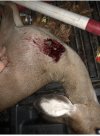Effectively designed copper monolithic bullets that shed their noses upon impact, and maintain a solid blunted shank, can be very lethal.
Over the past 7 yrs, we've shot sheep, Mt. goat, caribou, moose, grizzly, and brown bear.
Only recovered a couple bullet shanks. They don't need to look like a classical expanded lead-core jacketed bullet to be equally, or more, lethal on game.
Some might simply need to see them in action, for convincing. Even though meat damage is ~20% of frangible bullets, they can still drop game where they stand, upon impact.
Over the past 7 yrs, we've shot sheep, Mt. goat, caribou, moose, grizzly, and brown bear.
Only recovered a couple bullet shanks. They don't need to look like a classical expanded lead-core jacketed bullet to be equally, or more, lethal on game.
Some might simply need to see them in action, for convincing. Even though meat damage is ~20% of frangible bullets, they can still drop game where they stand, upon impact.
Last edited:


